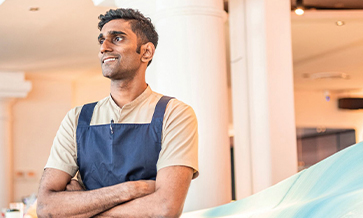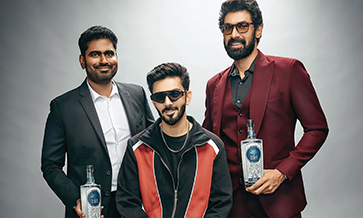Jonas Vittur, the high-profile Head Bartender at Copitas, the stylish hideaway located within Bengaluru’s Four Seasons Hotel, brings a wealth of global experience to his role. Roy Thomas spoke with him on his impressions of the Indian bartending scene and what it takes to be the best in this competitive field. Excerpts:
How do you see the bar scene in India vis-a-vis countries where you’ve served before?
The bar scene in India presents a fascinating contrast to my experiences in other countries. One notable aspect is the tight-knit community here, particularly prominent in cities across the north of India. In southern India, making and enjoying cocktails is still a relatively new trend.
Across India there’s a palpable sense of excitement and dynamism, with bars, cocktail culture, and interest in spirits all on the rise. Yet, competition in the Indian bar scene feels healthier compared to some other countries I’ve worked in.
Brands are investing significantly, which benefits the entire ecosystem of bars and establishments. There’s a clear passion and ambition among industry professionals to put India firmly on the global map of cocktail excellence.
Which spirit categories are most popular in India?
In India, Scotch whisky reigns supreme, boasting one of the highest consumption rates globally. It’s a staple choice for many patrons, reflecting a preference for quality and prestige. India also has some fantastic whiskeys. Japanese whiskies are also getting popular.
Gin is a top seller by volume, with its versatility and refreshing profiles appealing to a broad audience. Tequila is emerging as a noteworthy category, garnering increased interest among enthusiasts and cocktail aficionados. Lesser-known categories like Pisco or alternative white spirits present exciting opportunities for experimentation and education among consumers.
How do you prefer brands to pitch their products to you?
Nice question! Many new products lack substance and are backed only by a random story. To effectively pitch to me, brands should clearly communicate their vision and message. I appreciate when they approach me as an equal, keeping their storytelling concise and to the point.
It’s helpful when they clearly outline what they want from me, and what they can offer in return. Brands should also respect the value of time by keeping interactions efficient.
How do brand ambassadors influence your choice of products?
When a brand invests in ambassadors, it puts a face to their product and vision. The ambassador’s representation can either elevate the brand to new heights – or have the opposite effect if not executed well. If the ambassadors are passionate, knowledgeable and aligned with our values and approach, it can be incredibly beneficial.
Low- and no-alcohol cocktail programmes are on the rise. Cocktails are shifting away from sweet and synthetic ingredients. What is your experience?
There is a noticeable shift towards low and no-alcohol options, but it hasn't completely transformed the industry yet. While there’s global talk about it being a big trend, in practice, the increase in sales might not be as dramatic as portrayed.
From my experience, it could mean going from serving one table with such drinks to two tables a night. Some bars are placing a strong emphasis on creating original mocktails, but I think this trend is still gaining momentum.
At our bar, we prioritise using natural, fresh ingredients and homemade elements crafted from local produce. While we don’t have a set mocktail menu, we offer personalised mocktail options tailored to each guest’s preferences upon request.
Do you have storytelling around your cocktails?
Most people come to relax, chat with friends, and enjoy the ambience – not to decipher a complex menu. If guests express interest, we’re more than happy to provide additional information and guide them through our offerings. We often prepare drinks at the bar, inviting curiosity and conversation.
I believe that while menu design is important for clarity and pricing, it shouldn't be overly complicated or the sole source of storytelling. We aim to simplify the menu, focusing on key ingredients and flavours rather than overwhelming customers with extensive details.
Have you explored any Indian agave-based spirits?
I’ve had the pleasure of sampling Indian agave-based spirits, and they offer a fascinating twist on traditional Tequila. These locally produced spirits showcase unique flavours and characteristics distinct from their Mexican counterparts. Indian agave spirits hold promise for further exploration and innovation.
Do you notice any shift towards matured Indian rum varieties?
The potential of India’s sugarcane for rum production is indeed gaining recognition within the industry. While imported rum varieties dominate the shelves currently, there’s a notable shift in consumer attitudes toward Indian rum, especially those that undergo maturation processes.
I anticipate greater interest and appreciation for locally produced rums among discerning consumers. The challenge lies in educating consumers about the quality and distinctiveness of Indian rum varieties, particularly those that have been matured to enhance flavour profiles.
What does it take for bars to achieve world-class standards?
The top-tier bars in India are indeed on par with global standards, although the average standard may not be as exceptional. Many bars try to juggle too many aspects simultaneously. Instead, they should concentrate on excelling in one or two key areas that align with their strengths.
For instance, if a bar has an outstanding team, they should prioritise exceptional service and atmosphere. If the focus is more on creating a relaxed, lounge vibe, then the service aspect could be adjusted accordingly to match this ambience.
A visit to a bar should feel like a brief escape or a dream, where every element – from the music, lighting and ambience to the beverage, food and service standards – blends harmoniously. The experience should be intuitive and welcoming, without triggering unnecessary questions or confusion.
What is your most important learning (professional, social, personal) since you came to India?
Since coming to India, one of the most important lessons I’ve learned, both personally and professionally, is the value of patience and cultural openness. Initially coming for work in India, I found myself staying back for its people.
India taught me the necessity of refraining from immediate judgment based on past experiences. It’s essential to approach India with an open mind, taking time to absorb and understand its complexities, without imposing external standards.
This shift in perspective has deepened my understanding and appreciation for the diversity and uniqueness of Indian culture and society.














